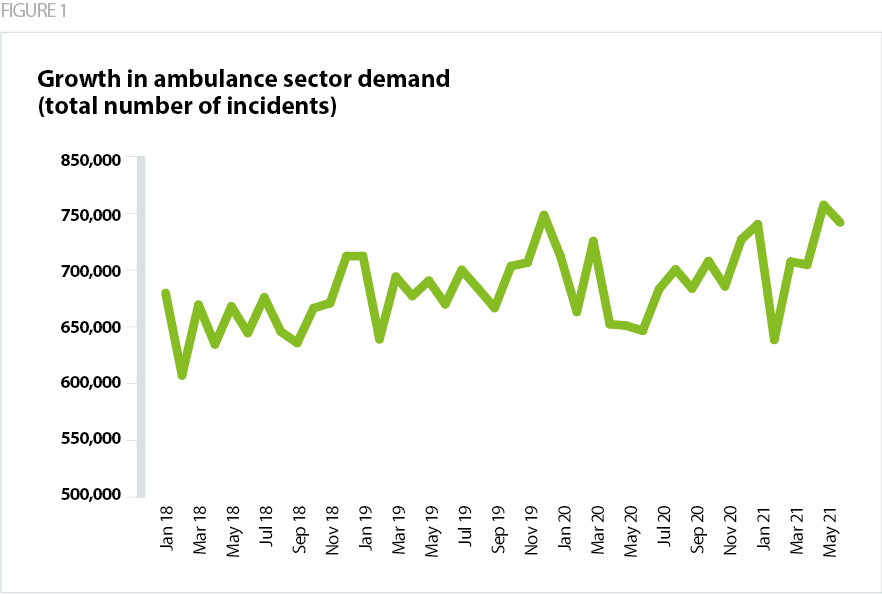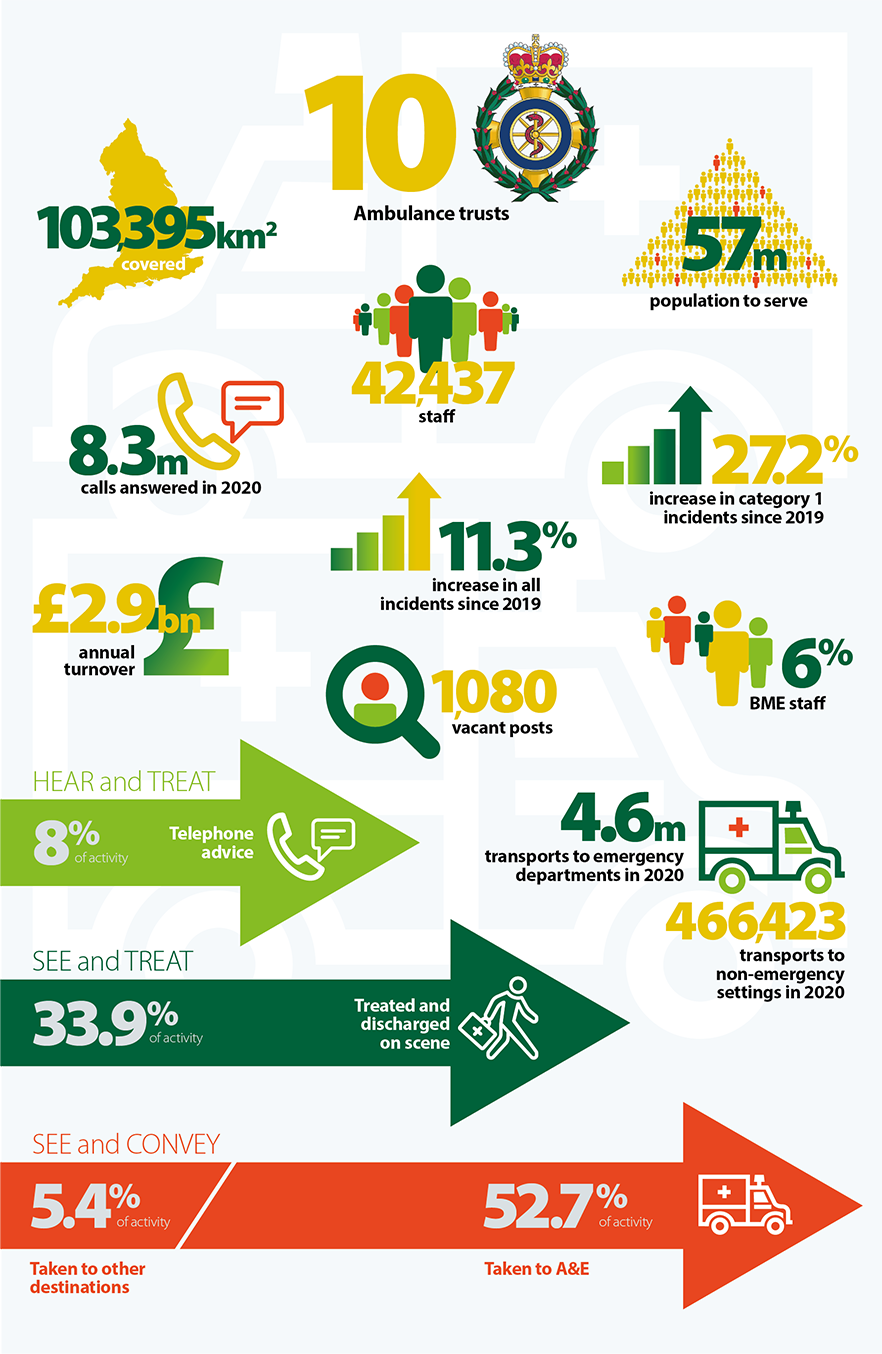The COVID-19 pandemic has highlighted the pivotal role of the ambulance sector in not only responding to emergency pressures but also acting strategically to alleviate pressures on the wider healthcare system. Ambulance staff and trust leaders have worked incredibly hard to accelerate change and adopt new ways of working while dealing with the intense demands of the frontline pandemic response. This has included huge strides in digital and remote services, recruiting and training additional staff and volunteers, and partnership working.
As the sector moves on to address living with COVID-19 in the longer-term and recovery from the pandemic, including managing the huge care backlog, it is vital that health and care systems lock in learning and the beneficial changes from new ways of working and integrated approaches to care delivery involving ambulance services.
Prior to the pandemic, the NHS long term plan set out a number of ambitions for ensuring the NHS is fit for the future and consolidated the expectation that local partners would increasingly plan and work collaboratively within ICSs (NHS England and NHS Improvement, January 2019). Increased system working, new care models and a system focus on avoiding costly inpatient care have already led to an expansion of the role of the ambulance service in many areas. As the longer-term impact of COVID-19 is becoming clearer, it is timely to look at the evolving role of the ambulance sector in responding to this, and how much more it has to offer.
Ambulance trusts are uniquely placed to play an instrumental role in COVID-19 recovery and the delivery of the long term plan through local health and care system transformation. Their role in care navigation and ensuring people are treated in the right place at the right time is often less well understood than their direct and very visible role in the UEC response. However, sometimes covering six or seven ICSs, the ambulance service can offer a joined-up perspective at a regional level and help to identify and drive integrated care solutions to the recovery challenge.
This report, jointly developed by NHS Providers and AACE, examines some key themes of COVID-19 recovery and the long term plan. We have selected three areas where the ambulance sector is driving initiatives that align with the priorities set out in the long term plan and the task of recovering the care backlog as rapidly as possible across all services: integrated care, innovative workforce models and digital transformation. In all of these areas, in addition to emerging and existing best practice, there are some barriers to maximising the full potential of the ambulance sector. We will look at how these barriers can be addressed.
Context of ongoing sector pressures
It is important to note the context in which ambulance services are working. Prior to the pandemic, all providers of NHS services were already feeling the effects of rising demand for services outpacing funding increases and workforce capacity, as well as the knock-on impact of very pressured primary and social care services. Ambulance service provision has historically been under-funded, with financial settlements not keeping up with ever-increasing activity, nor reflecting demand and capacity modelling. This has had an inevitable negative impact on patient experience and clinical outcomes, as well as the mental health and wellbeing of ambulance service staff. Dealing with demand pressures when service capacity is not correctly sized leads to knock on effects throughout the UEC system in terms of patient flow, and means development and training programmes are cancelled and innovation is constrained.
The pandemic has brought with it new challenges, both in relation to the direct COVID-19 response but also in the pent-up demand due to national lockdowns, higher acuity emergency presentations for those whose healthcare has been disrupted, and rising demand for mental health and paediatric care.
Trust leaders have told us of rising pressure on UEC services over recent months and fears about the operational pressures ahead over winter. Increases in demand for lower acuity care indicates that the public are struggling to access healthcare appropriately and this impacts on both 999 and ED walk-in demand. Infection protection and control policies continue to impact capacity and the recent easing of COVID-19 restrictions along with the seasonal impact of 'staycations' have meant that overall demand for services has risen.
Alongside this, trusts continue to face significant financial uncertainty. Due to the impact of the pandemic, NHS budgets were only set for the first half of the 2021/22 financial year – April to September – and the budgets were confirmed just 13 days before the start of the new financial year. At the time of writing, trust leaders are awaiting their budgets for September to March. This makes longer-term planning extremely challenging.
The latest month’s activity figures continue to highlight the intense pressure the ambulance service is facing. In June 2021, ambulance category one incidents increased by 8.1% since the previous month to 73,505 (5,523 more incidents). In comparison to a year ago, category one incidents have increased significantly by 62% (28,144 more incidents than June 2020). Compared to two years ago, before the pandemic, this is an increase of 27.2% (15,714 more incidents than June 2019) and overall activity has increased by 11.3%. For the second consecutive month, despite the best efforts of staff, the ambulance service has missed the average mean response time target of seven minutes for category one calls at seven minutes 54 seconds. The average response time for category two calls also continues to deteriorate, missing the 18 minutes target at 30 minutes 42 seconds.

Specific challenges for the ambulance sector related to increased demand include the following:
- Ambulance trusts cover large geographical footprints and although this enables economies of scale, it can make fast response times, especially in rural areas, a major challenge if resources are not matched to rising demand
- Emergency care is under particular strain with increased levels of demand in EDs and, as a result, increasingly high rates and lengths of ambulance handover delays, despite the best efforts of staff. In the 12 months to June 2021, 115,000 patients experienced a delay in handover at ED of longer than an hour.
- Lengthy delays in handovers continue to cause concern for patient safety, both in respect of those waiting on trolleys in corridors or held on ambulances outside ED, and for patients waiting for an ambulance response to their 999 call.
- Staffing is a major concern, with 1,080 (1.9%) vacancies across the sector, high rates of burnout, and the added risk of trusts losing their most experienced paramedics to primary care networks (PCNs). While trusts are starting to see the benefit of increased paramedic numbers coming through university, these numbers are constrained by the lack of clinical placements available, so intakes remain insufficient overall.
- The impact of relentless demand increases on top of the pandemic is taking its toll on staff wellbeing and attrition of more experienced staff remains a real challenge.
And yet, the sector has continually demonstrated its resilience, with trusts showing they are ideally placed to integrate care alongside system partners, through working across NHS 111, social care, primary care and other settings, reducing rates of avoidable conveyance to hospital. There has also been a concerted drive by the sector to respond to rising demand for mental health services, as illustrated in one of the case studies in this report.
The ambulance sector, COVID-19 recovery and the NHS long term plan
As the longer-term impact of COVID-19 becomes clearer, ICSs and providers face the task of recovering the care backlog over the next two to three years while simultaneously delivering on the original vision of the NHS long term plan and successfully navigating an evolving legislative and policy landscape relating to integrated care. Service transformation will be a key part of this journey, resuming the themes of the long term plan, including a strong focus on the prevention agenda and ensuring that care is delivered as close to home as possible. The pandemic has served to accelerate transformation in some areas such as the digital agenda and workforce flexibilities. It is important that this transformation is now sufficiently resourced on a long-term basis.
There is a risk that attention is focused on recovery and transformation within acute settings but all types of provider across ambulance, community, mental health and acute settings will play a key role in this task. There is also a risk that recovery efforts are focused on elective care while not fully addressing the wider post-COVID impact of delayed treatment and long COVID. For ambulance services, the recovery task will include improving patient flow in and out of hospital via effective patient transport services, paramedic referral to same day emergency care initiatives, and using alternative care pathways and digital tools to safely reduce avoidable conveyance to EDs. This will reduce the overall pressure on hospital services.
Concerns that were raised when the long term plan was originally published have renewed relevance in the fiscally-constrained period following the pandemic. These concerns related to uncertainties around pace of progress in the context of financial and workforce constraints and the lack of a solution to the ongoing social care crisis. The forthcoming autumn spending review should help to provide much-needed clarity on how the government is responding to these concerns. In the meantime, the ambulance sector is already playing a crucial role in the delivery of a raft of priorities set out in the long term plan and the learning from these new ways of working is hugely relevant in the context of recovering the care backlog.
The ambulance sector and system working
As part of the evolving policy landscape relating to ICSs, there is an opportunity to harness the regional knowledge and experience of ambulance services to scale up best practice and transform services. Best practice examples showcased in this report include integrated CAS, remote video triage, specialist paramedics signposting to local pathways, paramedic rotation, and PTS coordination.
In ongoing work to agree how ICSs will function as statutory bodies as of April 2022, AACE is currently engaging with NHS England and NHS Improvement and ICS leaders to explore the concept of a single regional commissioning board with oversight for ambulance services working across multiple ICSs. It is vital this dialogue continues, alongside conversations at ICS and place level, otherwise we risk fragmenting services and duplicating resources through multiple points of access within regions. Recent NHS England and NHS Improvement guidance positions the ambulance sector as playing an important role at neighbourhood, place, system and multi-system level.
Learning from the COVID-19 response has shown that there are opportunities to improve productivity and efficiency when certain aspects of service provision can be done collaboratively, at scale, across ICS and multi-ICS footprints. Ambulance trusts are well-placed to participate in, and lead, provider collaboratives at system level where it makes sense for them to do so. Trusts have highlighted the benefits of provider collaboration and partnership working as particularly relevant for the ambulance sector, where demand can be so significantly impacted by wider system issues. It is clear that ambulance trusts are already engaged in system working to varying degrees, and all are keen to realise the full value of their contribution in integrated UEC provision and population health management. This is illustrated by the case studies set out in this report, in which we see positive examples of system working leading to improved patient experience and reduced pressure on hospitals.
Going further, faster
There is undoubtedly a vital role for the ambulance sector in COVID-19 recovery, delivering the long term plan and achieving the four key ambitions of system working (improving outcomes, tackling inequalities, enhancing productivity, and supporting social and economic development). It is important, however, to be realistic about the NHS-wide (and social care) issues that need to be addressed in order to capitalise on this opportunity to full effect. We will explore these throughout the report but, in summary, they are as follows:
- policy alignment, ensuring the voice of the ambulance sector is involved in strategic planning and decision-making at national, regional, ICS and place level
- greater recognition of the ambulance sector’s role as providers of UEC, with many care episodes being concluded, either on-scene or over the phone, without the need for onward referral, and as care navigators, ensuring people are treated in the right place at the right time
- whole system investment to build on learning from the pandemic, to match the ambition set out in the long term plan, and to address historic underfunding.
FIGURE 2
About the ambulance sector in England, 2020-2021

